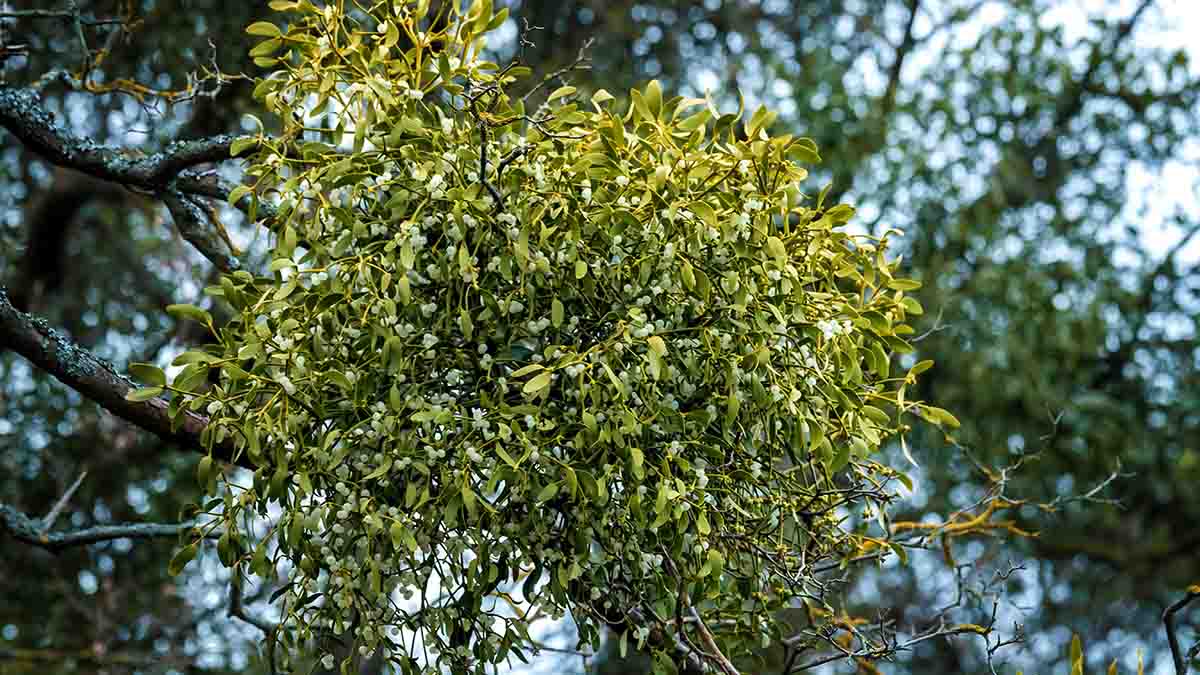It’s the “kissing ball” time of year. People are hanging sprays or orbs of mistletoe from chandeliers, doorways and ceilings hoping for a kiss from their favorite someone. Part of the Santalaceae family (Santa Claus has nothing to do with its name) this parasitic, perennial plant, maligned for most of the year, takes on a fun and festive note during the Christmas season.
The name “mistletoe” comes from the Anglo-Saxon word “misteltan.” In the Anglo-Saxon, the word “mistel” means “dung” and the word “tan” means “twig.” This evolved from the fact that birds ingest mistletoe berries and deposit their excrement on tree branches, thus “dung on a twig.” Over time, “misteltan” became spelled and pronounced “mistletoe.” In 18th century England, it became fashionable to kiss under a sprig or globe of mistletoe. This tradition continues today with folks enjoying a kiss under “dung on a twig.” How romantic.
The ritualistic use of mistletoe began with the Celtic Druids of England, Ireland and Scotland. This plant was seen as a symbol of fertility since it was green and lush with berries during the cold Winter months. In Norse mythology, the god Baldur was killed by an arrow of mistletoe. His mother, the goddess Frigg, asked the forces of nature to return her son to the living. After a time, Baldur lived once more. Showing her gratitude, Frigg forgave the mistletoe and vowed that all those who walked beneath mistletoe would receive a kiss and protection from harm. Sounds like this is where the custom of kissing under the mistletoe custom came from.
Generally known as a parasite, mistletoe is technically a hemiparasite, taking sustenance from both sunlight and other plants. You can find mistletoe high in the tops of poplar, hawthorn, apple, maple, oak, pine and others. It’s easy to spot in the Winter when the deciduous trees have lost their leaves because mistletoe remains green. In time, the host may perish from the parasitic needs of mistletoe or at least become weakened by it. Should you notice mistletoe moving in on a special tree, contact an arborist who may be able to eradicate it if found early.
There are estimated to be over 1,300 to 1,500 species of mistletoe worldwide. American or hairy mistletoe and dwarf mistletoe are the only varieties native to North America and can be found in the Chesapeake Bay area. Others have been introduced over the years. Today there may be 36 different species of mistletoe in our fifty states. Only the females of this dioecious plant are graced by white, pink or red berries. Flowers of the male plant are usually small and yellow in color.
Mistletoe establishes itself through seeds. The seeds are located inside the berries and are covered in a sticky substance which allows many of them to adhere to tree branches as they fall. Birds enjoy these berries—which can be toxic to humans—and they excrete the undigested seeds which often land on branches where they may take root in the bark; the plant will not establish itself in soil. This rooting process can take as long as two years. Other animals enjoy the mistletoe berries, such as deer, chipmunks and squirrels. Some birds build their homes in balls of mistletoe. Butterflies lay eggs on the leaves and enjoy the floral nectar; bees enjoy the nectar and collect the pollen.
It is tricky to find a purveyor of mistletoe these days. It is not as sought after as it once was and many folks purchase a faux orb of mistletoe to hang up during the holidays. Due to the belief that mistletoe can be toxic to humans, many florists who sell mistletoe remove real berries and replace them with artificial ones. European or Common mistletoe (Viscum album) is more toxic than the American (Phoradendron leucarpum) variety. The European kind can cause serious illness if consumed even in small amounts. The American mistletoe may cause stomach upset but not serious illness if only a small amount is ingested, according to the National Capital Poison Center. Nevertheless, keep mistletoe away from children and pets to be safe.
Whether fresh or faux, there’s nothing like a spontaneous smooch under the mistletoe. Remember the line from the beloved 1952 Christmas tune written by Tommie Connor that goes, “I saw mommy kissing Santa Claus, underneath the mistletoe last night.” So hang some mistletoe and enjoy the splendor of the season.
Barbara enjoys nature and the traditions of the Christmas season. She can be reached at: [email protected].

Let's keep in touch!
Keep up with the latest OutLook by the Bay information by signing up here. We promise not to waste your time.


